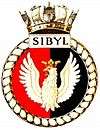HMS Sibyl (P217)
 | |
| History | |
|---|---|
| Class and type: | S-class submarine |
| Name: | HMS Sibyl |
| Builder: | Cammell Laird & Co Limited, Birkenhead |
| Laid down: | 31 December 1940 |
| Launched: | 29 April 1942 |
| Commissioned: | 16 August 1942 |
| Fate: | Broken up in 1948 |
| General characteristics | |
| Displacement: |
|
| Length: | 217 ft (66 m) |
| Beam: | 23 ft 6 in (7.16 m) |
| Draught: | 11 ft (3.4 m) |
| Speed: |
|
| Complement: | 48 officers and men |
| Armament: |
|

HMS Sibyl was an S-class submarine of the Royal Navy, and part of the Third Group built of that class. She was built by Cammell Laird and launched on 29 April 1942.
Career
She spent her wartime career in the Mediterranean, and in the Far East.
Mediterranean
Sibyl had a distinguished career, sinking numerous enemy ships, including the Italian merchant Pegli, the French (in German service) merchant St. Nazaire, the German auxiliary minesweeper M 7022/Hummer, five Greek sailing vessels and an unknown sailing vessel. She also unsuccessfully attacked the Italian merchant Fabriano, the German tanker Centaur and what is identified as 'a merchant of about 1500 tons' in a German convoy. Her commanding officer between June 1942 and 3 July 1944 was Lt. Ernest John Donaldson Turner, who was awarded the Distinguished Service Order on 23 June 1943. Turner was succeeded as commander by Lt. Huston (Tex) Roe Murray, who commanded her for the rest of the war. His First Lieutenant was Stephen Jenner, who later became the commander of the Canadian Submarine fleet.
Far East
On being transferred to operate in the Pacific in early 1945, Sibyl continued to cause losses to enemy shipping. The first Far East patrol was spent around the Andaman Islands and south of Singapore in the Malacca Strait. She sank a number of Japanese vessels with gunfire and scuttling charges in the Malacca Straits, and was strafed by aircraft and depth charged three times after these successful attacks.[1]
Sibyl was the first British submarine to surface in Singapore harbour after the Japanese surrendered. She operated out of Trincomalee, Ceylon from the depot ship HMS Forth.
After the atom bombs were dropped on Japan, Louis Mountbatten, Supreme Commander in the Far East wanted the surrender signed in Singapore and called for the fleet to be there. HMS Sibyl had been in the harbour the longest so her men were invited to the ceremony, which was held aboard HMS Sussex.[2] The mainly British and Australian prisoners of war held in Changi jail by the Japanese were released and taken on board the British ships and fed corned beef sandwiches and hot tea, as they were in terrible condition. It was noted that the entire harbour smelled of freshly baked bread for several days as the numerous ship's galleys were put to the task of feeding the starving prisoners of war.[3]
Post war
Sibyl survived the Second World War, and was sold off, arriving at Troon in March 1948 for breaking up.
References
- Colledge, J. J.; Warlow, Ben (2006) [1969]. Ships of the Royal Navy: The Complete Record of all Fighting Ships of the Royal Navy (Rev. ed.). London: Chatham Publishing. ISBN 978-1-86176-281-8. OCLC 67375475.
| Wikimedia Commons has media related to HMS Sibyl (P217). |